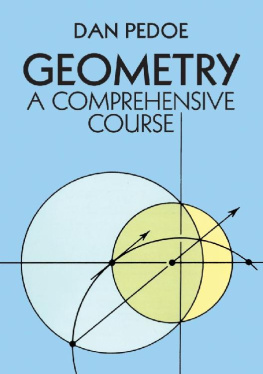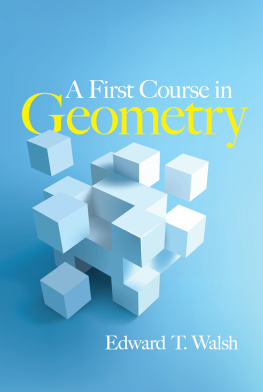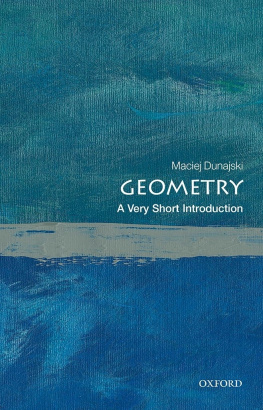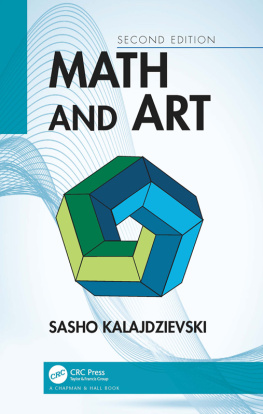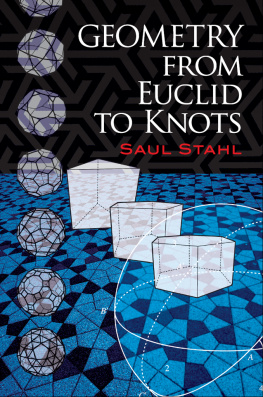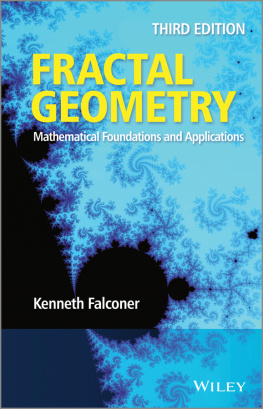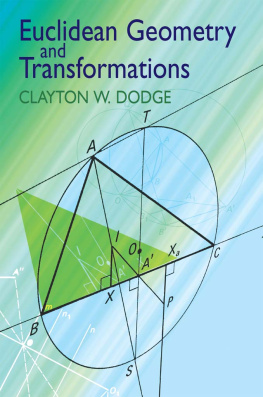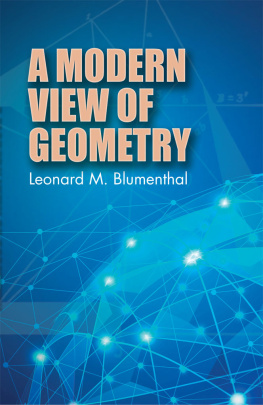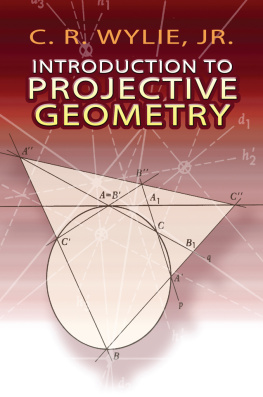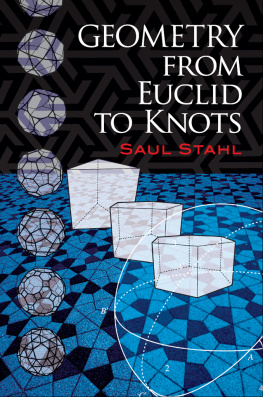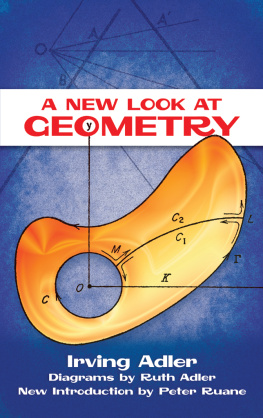... une poque o des savants minents, dous de grands talents gomtriques, s'efforaient de ne jamais dvoiler les ides directes et simples qui les avaient guids et de faire dpendre leurs rsultats lgants d'une thorie gnrale abstraite qui, souvent, ne s'appliquait que dans les cas particuliers en question. La gomtrie devenait une tude des quations algbriques, diffrentielles ou aux drives partielles: elle perdait ainsi tout le charme qu'elle doit au fait d'tre un art, et presque un art plastique.
Henri Lebesgue
Leons sur les Constructions Gomtriques,
Paris, 1950
GEOMETRY

A COMPREHENSIVE
COURSE

Dan Pedoe
Professor Emeritus, Mathematics
University of Minnesota
DOVER PUBLICATIONS, INC.
NEW YORK
To
William, Nadine,
Susan, Simon,
Oliver and Ian
Coypright 1970 by Cambridge University Press.
All rights reserved.
This Dover edition, first published in 1988, is an unabridged, corrected republication of the work first published by the Cambridge University Press, Cambridge, England, 1970, under the title A Course of Geometry for Colleges and Universities.
Library of Congress Cataloging-in-Publication Data
Pedoe, Daniel.
[Course of geometry for colleges and universities]
Geometry, a comprehensive course / by Dan Pedoe.
p. cm.
Reprint. Originally published: A course of geometry for colleges and universities. London : Cambridge University Press, 1970.
Bibliography: p.
Includes index.
ISBN-13: 978-0-486-65812-4 (pbk.)
ISBN-10: 0-486-65812-0 (pbk.)
1. Geometry. I. Title.
QA445.P431988 88-18691
516dc19 CIP
Manufactured in the United States by Courier Corporation
65812012
www.doverpublications.com
CONTENTS

Chapter IV: The Representation of Circles by Points in Space of
Three Dimensions
PREFACE

This book is based on a course given for the past few years at the University of Minnesota to junior and senior students, to first-year graduate students and to a Year Academic Institute of College teachers of geometry who had returned to the University for a year to learn more geometry. The main purpose of the course was to increase geometrical, and therefore mathematical understanding, and to help students to enjoy geometry. This is also the purpose of my book.
I believe, and in this I am supported by many reputable mathematicians, that a reasonable knowledge and appreciation of the scope and methods of elementary geometry is desirable for those who wish to study and to relish more abstract and advanced notions.
By elementary geometry I mean geometry as it is usually taught up to, but not including, a rigorous theory of algebraic curves. I include projective geometry of two and three dimensions, with some geometry of n dimensions in my definition of elementary geometry. The full scope of my definition can be initially realized by a look at the Table of Contents.
In this book I discuss the algebraic methods available for a study of elementary geometry. I have tried not to be tedious, and on the whole only those theorems of elementary geometry are studied which are of significance for further study. Whenever possible, pointers to this significance are indicated, in the text or in the Exercises, of which there are more than 500. The algebraic approach, although it is the main thread of my discourse, is never over-stressed. If a theorem appears to be more attractive with a geometric proof, this is also given. In any case, geometric insights are stressed all through.
The student reading this book is expected to have completed a course in linear algebra, of the kind indicated in my Geometric Introduction to Linear Algebra (Chelsea, New York, 1978). That is, some acquaintance with the ideas of a vector space is assumed, including some theorems on the solution of linear homogeneous equations, and also some matrix theory. But in other algebraic matters the book is self-contained, and there is a Preliminary with a summary of results the student will need.
The chapters of this book need not necessarily be taken in strict sequence. There is ample material for a year's course, or selections can be made which can be covered in one, two or three quarters. The second half of the book, which deals with the projective space of 2, 3 and n dimensions can be used independently of the first part.
, which need not be taken first, shows what kinds of theorem in real Euclidean and affine geometry can be proved by using vectors. The student who has only come across vectors in a few sections of a book on the calculus may be surprised at the scope of the theorems which are amenable to the algebra of vectors. Later in the chapter the exterior algebra of Grassmann is introduced, and developed a little, and the power of the methods then available is demonstrated.
coaxal systems of circles are mapped onto lines in space of three dimensions, and we therefore need to know something about the systems which have such a simple map. Inversion is also studied, not only for its theoretical importance, but because it never fails to fascinate the student. The idea that geometry is an attractive study is not overlooked in this book.
discusses the representation of circles by points in E3, real Euclidean space of three dimensions, and here the interplay between theorems in space of different dimensions (two and three in this particular case) first becomes clear. The ability to regard theorems from different points of view is probably the hall-mark of a geometer, and in this chapter a student may receive his first training in this desirable art. At the end of the chapter an algebra of circles is introduced. This is a further application of the ideas of Grassmann, and although the use made of the algebra is not new, the explanation is new and, it is hoped, no longer almost metaphysical. As in the preceding chapters, there are numbers of Exercises, not completely trivial, on which the student can test his understanding of the text. Nobody has, as yet, discovered a better way of learning mathematics.
deals with mappings of the Euclidean plane, especially isometries. These mappings have already appeared in earlier chapters, but are now considered from the point of view of the algebra of complex numbers. This algebra has many advantages, and some disadvantages, but it is important for the student to become familiar with the field of complex numbers. Wherever proofs using complex numbers are not completely satisfactory, aesthetically speaking, an alternative proof using Euclidean geometry is indicated. Some group theory is used in this chapter. Elementary mappings of the Euclidean plane have, of course, been an important part of elementary geometry for many years. Recently they have become important in the foundations of geometry.
continues the discussion of mappings by considering the Moebius transformations of the inversive plane, and ends with a detailed discussion of the Poincar model of a hyperbolic non-Euclidean geometry. There is not too much development here, since once the student is convinced that Euclid's parallel axiom can be dispensed with, the rest is not necessary for our purpose, and can be found in other texts. The Appendix lists the Propositions of Euclid, as a useful reference.
Next page
